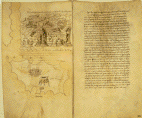
Giovanni de Matociis (d. 1337), known as Giovanni Mansionario because of his official office in the cathedral at Verona, used the very rich library preserved there to splendid effect. A prescient scholar, he proved that there had been not one but two Plinys, the elder who wrote the "Natural History" and the younger who described the elder's death in the eruption of Vesuvius. Both his erudition and his critical skills served him well in the writing of his immense "Historia imperialis," a biographical compilation that began with Augustus. He shows a real interest in trying to recreate ancient Roman life in three dimensions, as is clear from his stiff but fascinating marginal drawings of emperors' heads (derived from Roman coins) and a Roman circus (which he based not on the remains of the Arena in Verona but on textual information from a late antique encyclopedia).
Chig. I. VII 259 fols. 12 verso-13 recto arch01 TG.01

Many Roman families took a deep interest in the exploration of ancient ruins. Cristoforo Buondelmonti dedicated this treatise on his adventurous exploration of the islands of the Aegean to Cardinal Giordano Orsini in 1420. All extant manuscripts are copies of the original, nonetheless the illustrations suggest the nostalgic and obsessive love for the classical past that made Buondelmonte risk capture by pirates and death from starvation. Here, carefully drawn ruins evoke the pathos of what he took to be the ruins of Troy.
Chig. F. V 110 fols. 39 verso-40 recto arch02 TG.02

In the papal curia in the 1420s and after, some papal secretaries became expert archaeologists. This splendid miniature of Poggio represents one of the most adventurous of all the fifteenth- century explorers of the classical past. Poggio Bracciolini walked the streets and inspected the stones of Rome, intent on preserving and recording every detail and "stupefied" by the continuing destruction of important ancient buildings. In this book he makes the theme of fortune's power to destroy the pretext for a detailed firsthand survey of Rome's ruins. It begins dramatically, with Poggio and a friend surveying the scene visible from the top of the Capitoline, and includes detailed study of such technical matters as the composition of the city's walls.
Urb. lat. 224 fols. 1 verso-2 recto arch03 TG.03

Pomponio Leto, a famous teacher as well as a brilliant antiquary, lectured in Rome on many classical texts, including the work of the Roman scholar Varro on the Latin language. This text gave him the pretext for discussion of many Roman customs, places, and buildings, which he evidently described in detail and even showed to his students. The student who copied this manuscript had a lively talent for drawing, seen here in his sketches of the Baths of Diocletian. As a whole the lectures show the rich way in which Roman texts and antiquities illuminated each other in the interdisciplinary scholarship of the Roman humanists.
Vat. lat. 3415 fols. 16 verso-17 recto arch04 TG.08

In his view of Chios and Mytilene, Buondelmonti shows the site where he saw "the tomb of the bard Homer" (Chios) and where, as he knew, Sappho, Theophrastus, and other distinguished ancients had lived (Mytilene).
Urb. lat. 459 fols. xxix verso-xxx recto arch05 TG.61